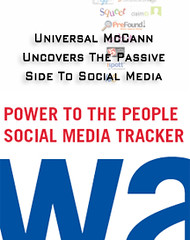Globally, 73 percent of Internet users are reading blogs with 48 percent seeking out consumer generated content. In some countries, like South Korea, new media has already edged out old media with 77 percent of Internet users reading blogs and only 58 percent reading the mainstream press.
But here’s the rub. As Adweek pinpointed in the Universal McCann study, consumers in the U.S. and Western Europe are more likely to be passive social media participants — sharing videos and reading blogs — while those in emerging markets are more likely to be content creators.
Social Media Engagement Is Not A Measure
According to the study, more than 60 percent of Internet users in the U.S. read blogs, but only 26 percent are blog content creators. In contrast, more than 70 percent of Internet users blog in South Korea and China.
"By and large, in the U.S. we're a country of voyeurs," said David Cohen, U.S. director of digital communications at Universal McCann, which conducted the study. "We love to watch and consume content created by others, but there's a fairly small group that are doing that creation -- unlike China, which is a country of creators."
This might ruffle some feathers among social media experts that have inflated the “value” of social media engagement (comments, bookmarks, and links from other bloggers) over other forms of engagement (regular readers, tangible actions, and changes in behavior). The reason: companies that create sites reliant on user created content only appeals a fraction of total audience and not necessarily for the right reasons.
It also hints at why the sudden surge in “my” URL Web sites might be the wrong illusion. Simply adding “my” to a Web site does not make it automatically more personal.
Sure, the idea worked for some and there is no dispute that people want to feel connected to the sites they visit. However, one must always take care to remember that the participants they are catering to are most likely the choir and not the parishioners (never mind those who never made it into the service).
Engagement Takes Many Forms, Not Just One
If we consider that there are approximately three passive visitors for every one participant, then the most vocal of the total audience might not always be representative of the total population. In other words, if companies define engagement too narrowly, then they might inadvertently disengage passive participants — people who are engaged and take their actions offline.
It’s something to think about, especially because there is still ample wiggle room between online traffic measures. Enough so that digital-advertising executives have long doubted comScore and Nielsen Online because they already know that there are research gaps. Even less reliable is Alexa, despite being the favorite among bloggers to compare scores and its frequency of use among ranking algorithms.
The bottom line is that engagement takes many forms. Some people might leave a comment or cite what you write on their blogs. But then there are also those who might read a company blog faithfully and only take offline actions.
For example, the last time I had a question about a home repair, I sourced the company and found the information. I didn’t blog about it nor did I leave a comment, but I did use the information to get the job done.
While I might be counted as being engaged by their social media consultant, I most certainly might have been more engaged than the person who had left a comment that disagreed with their solution. You see, unlike the commenter who theorized, I actually did the task and found that it worked.



















1 comments:
Hi!!! copywriteink.blogspot.com is one of the most outstanding innovative websites of its kind. I enjoy reading it every day. I will be back.
Post a Comment